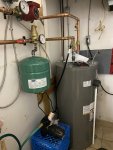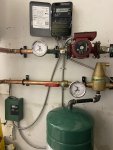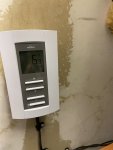I am finally successful with my in floor heating project.
Background:
My site is a 2 bay car wash in a convenience store and gas station plaza. We are located an hour from Ottawa. When I purchased the property 3 years ago the car wash was non functional. The first year operating the site was a nightmare. We weeped so much water that we lost money and had regular freeze ups. As I gained a better understanding of the system, it made things a bit better for the second year and the blowout system that I installed helped curb the weep cost for the night. However, there was no floor heat as the previous owner had sold the boilers and did not repair. This resulted in a slippery floor and a lot of labour to remove the constant ice buildup.
Project:
As my site is a small volume site I did not want to invest a lot of money in the floor heat. It could be that with everything said and done, we might loose more money trying to have the floors heated. During my research I came across a paper by Waterloo university that mentioned using hot water tanks as means for radiant heat. Spoke to few companies in the area who said it could not be done. However, I pursued the matter.
Components:
To simplify the system I opted for a closed system. I bought the components on wholesale except the electric hot water tank and had a local plumber do the installation.
As the project is an experiment, I bought 40 gallon electric hot water tank and used 50-50 glycol.
Working:
An Aube thermostat with an in-floor sensor is connected to a Taco relay. I set the thermostat at 5 degrees as that is the lowest temperature setting. However, as I am using electric, I wanted the system to run when the hydro is cheaper. I installed an Intermatic programmable timer which basically cuts of the power to the relay. I programmed it for 30 mins ON and 45 mins OFF cycle allowing sufficient time for the hot water tank to heat up.
Leaks:
The plumber performed a pressure test last year and said there are no leaks in the system. However, when we pressurized the system it would loose pressure over 3-4 days. So anyone planning to test their existing piping, perform a 7 day pressure test.
I did not want to rip the concrete and install new piping. I came across a product Geo Loop which is manufactured in Canada and claims to stop small leaks.But given my luck it was not compatible with my glycol mixture and turned lumpy. As this December we had days with positive temperatures, I drained the glycol, and circulated water mixed with Geo Loop. The solution worked and the system is holding pressure.
Next Steps:
The system is working flawlessly (fingers crossed) and come this summer I plan to install a Takagi unit and follow in the footsteps of 2Biz. The propane will be cheaper than electric, however for this year the experiment is a success.
Background:
My site is a 2 bay car wash in a convenience store and gas station plaza. We are located an hour from Ottawa. When I purchased the property 3 years ago the car wash was non functional. The first year operating the site was a nightmare. We weeped so much water that we lost money and had regular freeze ups. As I gained a better understanding of the system, it made things a bit better for the second year and the blowout system that I installed helped curb the weep cost for the night. However, there was no floor heat as the previous owner had sold the boilers and did not repair. This resulted in a slippery floor and a lot of labour to remove the constant ice buildup.
Project:
As my site is a small volume site I did not want to invest a lot of money in the floor heat. It could be that with everything said and done, we might loose more money trying to have the floors heated. During my research I came across a paper by Waterloo university that mentioned using hot water tanks as means for radiant heat. Spoke to few companies in the area who said it could not be done. However, I pursued the matter.
Components:
To simplify the system I opted for a closed system. I bought the components on wholesale except the electric hot water tank and had a local plumber do the installation.
As the project is an experiment, I bought 40 gallon electric hot water tank and used 50-50 glycol.
Working:
An Aube thermostat with an in-floor sensor is connected to a Taco relay. I set the thermostat at 5 degrees as that is the lowest temperature setting. However, as I am using electric, I wanted the system to run when the hydro is cheaper. I installed an Intermatic programmable timer which basically cuts of the power to the relay. I programmed it for 30 mins ON and 45 mins OFF cycle allowing sufficient time for the hot water tank to heat up.
Leaks:
The plumber performed a pressure test last year and said there are no leaks in the system. However, when we pressurized the system it would loose pressure over 3-4 days. So anyone planning to test their existing piping, perform a 7 day pressure test.
I did not want to rip the concrete and install new piping. I came across a product Geo Loop which is manufactured in Canada and claims to stop small leaks.But given my luck it was not compatible with my glycol mixture and turned lumpy. As this December we had days with positive temperatures, I drained the glycol, and circulated water mixed with Geo Loop. The solution worked and the system is holding pressure.
Next Steps:
The system is working flawlessly (fingers crossed) and come this summer I plan to install a Takagi unit and follow in the footsteps of 2Biz. The propane will be cheaper than electric, however for this year the experiment is a success.
Attachments
-
1.9 MB Views: 22
-
1.8 MB Views: 21
-
1.6 MB Views: 19





